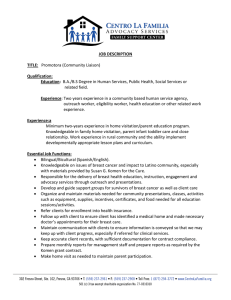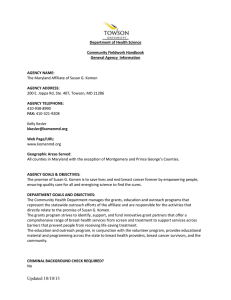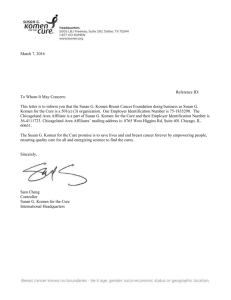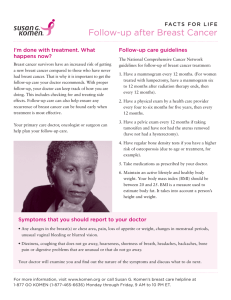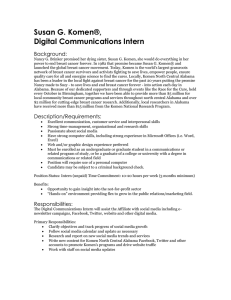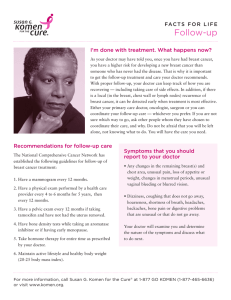Follow-Up After Breast Cancer Treatment
advertisement
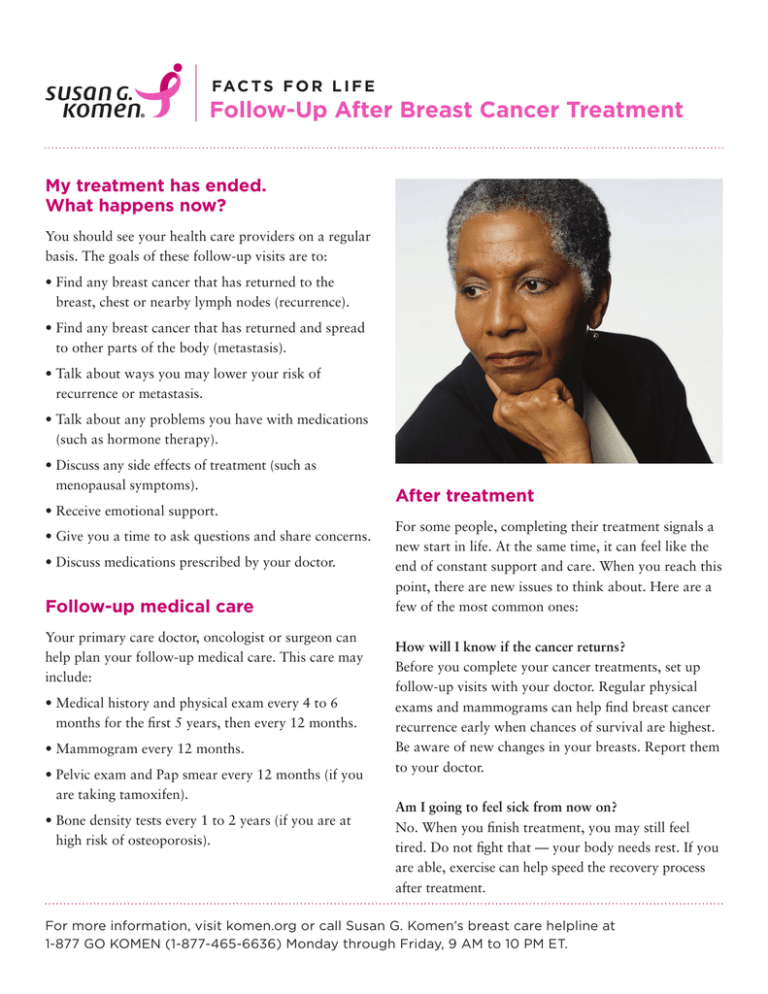
FA C T S F O R L I F E Follow-Up After Breast Cancer Treatment My treatment has ended. What happens now? You should see your health care providers on a regular basis. The goals of these follow-up visits are to: • Find any breast cancer that has returned to the breast, chest or nearby lymph nodes (recurrence). • Find any breast cancer that has returned and spread to other parts of the body (metastasis). • Talk about ways you may lower your risk of recurrence or metastasis. • Talk about any problems you have with medications (such as hormone therapy). • Discuss any side effects of treatment (such as menopausal symptoms). • Receive emotional support. • Give you a time to ask questions and share concerns. • Discuss medications prescribed by your doctor. Follow-up medical care Your primary care doctor, oncologist or surgeon can help plan your follow-up medical care. This care may include: • Medical history and physical exam every 4 to 6 months for the first 5 years, then every 12 months. • Mammogram every 12 months. • Pelvic exam and Pap smear every 12 months (if you are taking tamoxifen). • Bone density tests every 1 to 2 years (if you are at high risk of osteoporosis). After treatment For some people, completing their treatment signals a new start in life. At the same time, it can feel like the end of constant support and care. When you reach this point, there are new issues to think about. Here are a few of the most common ones: How will I know if the cancer returns? Before you complete your cancer treatments, set up follow-up visits with your doctor. Regular physical exams and mammograms can help find breast cancer recurrence early when chances of survival are highest. Be aware of new changes in your breasts. Report them to your doctor. Am I going to feel sick from now on? No. When you finish treatment, you may still feel tired. Do not fight that — your body needs rest. If you are able, exercise can help speed the recovery process after treatment. For more information, visit komen.org or call Susan G. Komen’s breast care helpline at 1-877 GO KOMEN (1-877-465-6636) Monday through Friday, 9 AM to 10 PM ET. Side effects like nausea and hair loss should go away after treatment ends. If nausea or other side effects last, tell your doctor. Should I get back to my usual routine? Getting back to the things you used to do, even if it takes some time, will help you feel better. Adopt a healthy lifestyle that includes exercise and a healthy diet. Will it ever be over? Believe it or not, there may come a day when you no longer worry about cancer every day. It is normal to have some anxiety though. This should lessen over time. You may be able to get support from other breast cancer survivors who are in the same place as you are now. There are often support groups for people at specific stages of illness or recovery. You may find groups that are run by breast cancer survivors. These groups can be a helpful source of information and support. Symptoms that should be reported to your doctor Resources Susan G. Komen® 1-877 GO KOMEN (1-877-465-6636) www.komen.org American Cancer Society’s Reach to Recovery Program 1-800-ACS-2345 www.cancer.org American Society of Clinical Oncology 1-888-282-2552 www.asco.org Living Beyond Breast Cancer 1-888-753-5222 www.lbbc.org National Comprehensive Cancer Network 1-866-788-NCCN www.nccn.org Related fact sheets in this series: • Getting the Support You Need • Healthy Living • Any change in the breast or chest area • If Breast Cancer Returns • Shortness of breath • Life After Breast Cancer Treatment • Weight loss • Lymphedema • Bone pain Based on symptoms, your doctor may order tests. Follow-up tests Depending on the symptoms, blood tests (including tumor marker tests) and imaging tests (including bone scans, CT scans, PET scans and chest X-rays) may be used to check for metastases. For people with no symptoms of metastases, blood and imaging tests (other than mammography) are not a standard part of follow-up care. Tests to check for early metastases in people with no symptoms do not increase survival. The above list of resources is only a suggested resource and is not a complete listing of breast cancer materials or information. The information contained herein is not meant to be used for self-diagnosis or to replace the services of a medical professional. Komen does not endorse, recommend or make any warranties or representations regarding the accuracy, completeness, timeliness, quality or non-infringement of any of the materials, products or information provided by the organizations referenced herein. The Running Ribbon is a registered trademark of Susan G. Komen. © 2016 Susan G. Komen® Item No. KO0083 9/16
